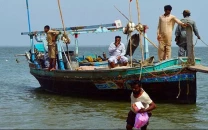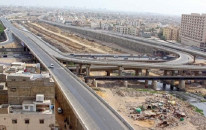Occupation 101: Manghopir – how it became a no-go area
The Express Tribune explores step-by-step exclusion of a neighbourhood allegedly at the hands of the Taliban.

The Express Tribune explores the step-by-step exclusion of one of Karachi’s neighbourhoods allegedly at the hands of the Taliban. DESIGN: AMNA IQBAL
With the law enforcers combing the city’s no-go areas following the recent Supreme Court orders, The Express Tribune explores how Manghopir turned from a land of the crocodiles into a no-go area.
Before the military operation in the country’s tribal areas in 2009, Manghopir, Sultanabad, Pakhtunabad, Kunwari Colony, Awan Colony and New Mianwali Colony wore a deserted look. Given the low population, the neighbourhood was popularly known as the ‘forest of Manghopir’. The area was also ethnically diverse occupied mostly by low-income families.
The neighbourhood witnesses some changes when the internally displaced persons (IDPs) made their way down to Karachi and settled in various Pashtun-dominated areas. These IDPs initially stayed with their relatives and then bought a number of plots. Most of them returned once the operation ended, but those who were affiliated with the Taliban and had used the migration as a means to escape the operation, stayed back.
“The Taliban came here to pass their time, but they changed their intentions when they arrived,” claimed a former Pirabad SHO. “They didn’t have to face the army here, there were enough places to live, and Karachi provided ample opportunities for them to collect funds through extortion and kidnappings for ransom.”
According to him, setting up a no-go area is easier than eliminating one. “You just have to stand in one area with weapons, and when law enforcers try to enter, you just open fire at them,” he told The Express Tribune. “It’s not hard at all.”
The older residents of Manghopir admitted that the Taliban gained strength in this area due to support from the community. “The reaction was mixed – some people agreed with their mentality so they joined hands willingly, others were forced,” a resident told The Express Tribune. The families who resisted were threatened by the Taliban, who would also kill their family members settled in the tribal areas, he added.
Step 1 Settling down
Once the Taliban made up their mind about settling down in Karachi, they approached the land mafia. This ethnically diverse mafia allotted illegal plots and sold it to the Taliban on minimal rates, such as Rs30,000 to Rs40,000 for a 100-square-yard plot. “If you look at it in one way, they carried out illegal work in a legal manner,” said an estate agent, on the condition of anonymity. As the Taliban became strong, families of other ethnicities started moving out of the area, leading to further militant-dominance. “You won’t imagine, but overnight truck loads of Mehsuds came to this area and each man bought around 10 plots each,” said another estate agent.
Step 2 Joining hands with locals
Once the plots were finalised and the Taliban had a permanent abode, they joined hands with local criminals and offered them to join their ranks. It worked both ways as the Taliban wanted manpower and the local criminals aspired to work on a larger platform. “Getting these criminals on board helped Taliban procure people who were already trained and knew how the law enforcers in Karachi worked,” said an official.
Setep 3 Becoming proactive
With a stronger team of militants, the Karachi Taliban became proactive and started taking action against what they called were “vulgar” acts in society. They cut down internet and television cable services, shut down shops selling CDs and DVDs and started holding ‘Amn Committee’ jirgas in their neighbourhoods.
“Vulgarity is not allowed in our religion, so if Taliban took action against it, it wasn’t wrong,” admitted a resident, adding that they had no trust in the government or the police. “It is better for us that our own people hold a jirga and decide matters.”
Step 4 Collecting money
In the fourth stage, the Taliban started gathering funds through extortion, kidnappings for ransom and bank robberies. Given the thriving marble industry in Manghopir, the neighbourhood was an ideal spot for the militant to force businessmen to pay up. “Our whole world has changed in the past two years,” said a marble factory owner, on the condition of anonymity. “The criminals who charged up to Rs100,000 as extortion are now charging up to a million rupees under the Taliban banner.” The traders are caught between a rock and hard place as they know there will be another ‘gangster’ waiting for them if they relocate to another neighbourhood. “Where do we even go that’s safe?”
Step 5 Up in arms
Throughout their nearly two-year journey, the Taliban have collected a large number of weapons and explosives. “They didn’t come out in the open until now because they were making sure they were strong enough,” said a former Manghopir SHO. “Initially, they would react only when the law enforcers took action. But now, they are targeting them even when they stay out of their areas.”
Published in The Express Tribune, April 4th, 2013.



















COMMENTS
Comments are moderated and generally will be posted if they are on-topic and not abusive.
For more information, please see our Comments FAQ